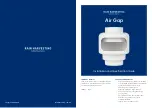
4
Specifications:
SR-2024N
SR-2236N
Stock Number.................................................................754020................................................... 754026
Capacity (mild steel) .......................................................20 .................................................................. 22
Maximum Forming Length ..............................................24” ................................................................36”
Number and Diameter of Rolls ........................................3 and 2”................................................. 3 and 2”
Minimum Forming Radius ...............................................1” ....................................................................1”
Wire Grooves..................................................................3/16” 1/4", 5/16”......................... 3/16” 1/4", 5/16”
Overall Dimensions (LxWxH) ..........................................37” x 17” x 17” ............................. 49” x 17” x 17”
Uncrating and Clean-Up
1.
Remove the crate from around the machine.
2.
Carefully clean all rust protected surfaces
with a mild solvent or kerosene and a soft
rag.
Do not use lacquer thinner, paint
thinner, or gasoline.
These will damage
painted surfaces.
3.
Coat all machined surfaces with a light coat
of oil to inhibit rust.
4.
Remove the bolts holding the machine to the
skid.
5.
Carefully move the machine to a well lighted
area on a solid, level work bench, and
secure to the bench with lag screws or bolts.
6.
Machine location must allow access to all
sides.
Front Rolls
The (#) in the text refers to the breakdown.
1.
The upper and lower rolls #23 & #24 carry
the material through as the crank handle
#33 is turned in a clockwise direction.
2.
The lower roll adjustment knobs #12 are
used to move the lower roll #24 up and
down for different gauge material.
3.
The gap between the two front rolls should
be equal at both ends.
Rear Roll
1.
The rear roll #25 can be adjusted to control
the radius by turning adjustment knobs #13.
2.
The gap between the rear roll and the two
front rolls should be equal at both ends of
the roll to assure an equal radius at both
ends of the material.
Releasing the Material
1.
Once the material has been rolled release
the material from the roll by lifting handle
#29.
Move the handle bracket out of the
way.
2.
Lift the upper roll #23 by moving lever #3 to
the right so that the material can be
removed.
Rolling Wires
There are three wire grooves in the lower and
rear rolls that will accommodate a 3/16”, 1/4",
and 5/16” wire.
Lubrication
The machine must be lubricated every day of
service with a few drops of oil. An oil pinhole is
located at both ends of the lower roll #24, and
rear roll #25.
The upper roll #23 has two oil
pinholes on the left side. The right side can be
lubed by opening the handle #29, and lightly
oiling the end of the upper roll shaft.
Every thirty days of operation grease the gears
by removing the outer hex nut #7, and gear
cover #18.
Lightly oil the rolls when not in use to prevent
rust.
























